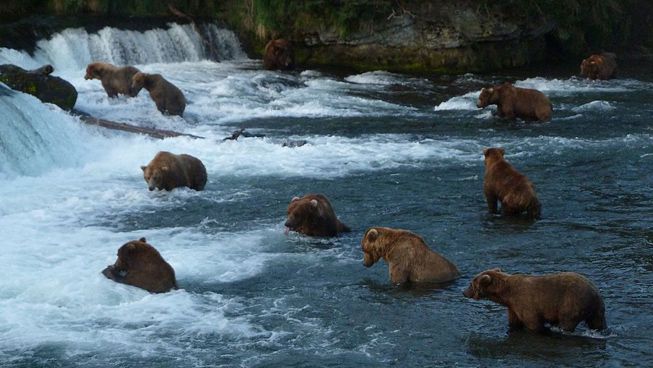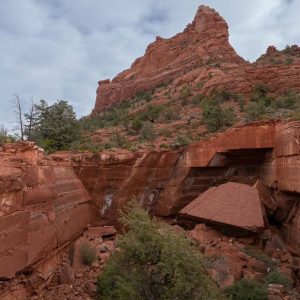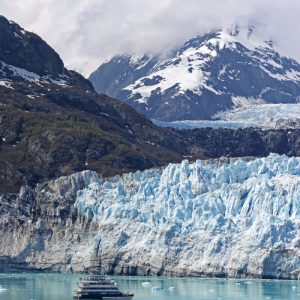Contents
- 11.The coolest place to see rare foxes and brown bears
- 10.A forgotten tract of Route 66
- 9.America’s most remote scenic drive
- 8.A forgotten part of Yosemite wilderness
- 7.Racetrack at La Playa
- 6.A hidden canyon complete with a fish-filled river
- 5.Historic, hidden campsites
- 4.Huge natural, stone “cannonballs”
- 3,Fragile rock formations not noted in any guidebook
- 2.Neon blue lakes reflecting the wilderness
- 1.A remote beach paradise in the South Pacific
There are 59 national parks in America. Each one has its own popular attractions. We researched these places and discovered that several of them have a unique secret place where one can get away from the crowds. Here they are
11.The coolest place to see rare foxes and brown bears
Katmai National Park and Preserve, Alaska
Katmai National Park and Preserve includes over 4 million acres of wilderness. There’s also Brooks Falls and Brooks River where the bears go fishing. The best place there, however, is Shelikof Strait. Travel via boat or on foot, but if you want an education on wildlife just get there.
You’ll learn about birds, marine animals, the “cross fox”, and all there is to know about bear-spotting.
10.A forgotten tract of Route 66
 100vw, 696px” data-lazy-src=”https://acovalue.info/wp-content/uploads/2023/10/2-4-696×564-1.jpg” /><img decoding=)
Petrified Forest National Park, Arizona
It’s known by many names “The Mother Road”, the “Main Street of America”, and the “Will Rogers Highway.” The original route is no longer, but stretches of it are still available to travel. isiting the Petrified Forest? You’ll be able to see a forgotten stretch of the famous Route 66. It’s overgrown, but the old Route 66 road signs remain.
There’s also a special marker on the ground at the nearby Route 66 informational pull out.
9.America’s most remote scenic drive
 100vw, 696px” data-lazy-src=”https://acovalue.info/wp-content/uploads/2023/10/3-3-696×464-1.jpg” /><img decoding=)
Home to one of the largest canyons in the country, this remote area can only be reached via Highway 180. You’ll enjoy 50 miles of beautiful scenery as you travel into California’s Sierra Nevada Mountains’ foothills and Sequoia groves. 2,700 feet below you will find Kings River, geologic formations, meadows, waterfalls, and a lot of wildlife.
Photographer Ansel Adams work in this area aided in bringing it federal park protection.
8.A forgotten part of Yosemite wilderness
 100vw, 696px” data-lazy-src=”https://acovalue.info/wp-content/uploads/2023/10/4-3-696×522-2.jpg” /><img decoding=)
Yosemite National Park, California
Visit the less popular yet still noteworthy northwest side just 38 miles from the center of the park. According to John Muir, this crowd-free zone, known as Hetch Hetchy, was as beautiful as Yosemite 100 years ago. Back in 1938 the area was flooded and converted to a huge 117-billion gallon hydro-electric reservoir in order to provide San Francisco residents with water.
Today the surroundings are full of wildlife and there are forests, hiking trails, lakes, and waterfalls.
7.Racetrack at La Playa
 100vw, 696px” data-lazy-src=”https://acovalue.info/wp-content/uploads/2023/10/5-3-696×524-1.jpg” /><img decoding=)
Death alley National Park, California/Nevada
Here, 26 miles from the behebe Crater, you can see the soon-to-be-famous sailing stones. They are essentially boulders that shift with the weather and permanently impact the ancient, arid lake bed.
The road there is rugged enough that you will need a high-clearance vehicle. Drive a mile beyond the trailhead and park. Hike to the base of the mountain if you wish to see a majority of these boulders.
 100vw, 620px” data-lazy-src=”https://acovalue.info/wp-content/uploads/2023/10/6-3-7.jpg” /><img decoding=)
Gunnison National Park, Colorado
This stark hidden canyon, found in one of the least-visited parks in the .S., is the most intimidating and imposing you might ever see. At the bottom, you’ll find the Gunnison River.
It’s a quiet place to camp and to fish for salmon and trout. It’s a great place for photographers too since the high walls block the sometimes pesky Rocky Mountain winds. You can hike in or take the East Portal Road via the South Rim.
 100vw, 600px” data-lazy-src=”https://acovalue.info/wp-content/uploads/2023/10/7-2-5.jpg” /><img decoding=)
Everglades National Park, Florida
The well-known Everglades National Park spans 1.5 million acres and includes both saltwater and freshwater ecosystems. Hire a nautical guide and travel deep inside the drifting mangrove trees. There you’ll discover a few little known but still historical “chickee” campsites.
Accessible only via boat, they are raised wooden covered docks that for hundreds of years were used as courier stops. Camp there and take in the sights and sounds of the life within the trees, water, and even the air.
4.Huge natural, stone “cannonballs”
 100vw, 696px” data-lazy-src=”https://acovalue.info/wp-content/uploads/2023/10/8-3-696×645-1.jpg” /><img decoding=)
Theodore Roosevelt National Park, North Dakota
The Cannonball Concretions appear to be gigantic cannonballs. They are composed of clay, shale, sandstone, and various mineral compounds. Their numbers multiply as they are unearthed by erosion which wears away their natural protective shields.
They can be found right off the paved road in the less-visited north district. Set up camp in the highly praised Juniper Campground. Then cross the park’s road to check out the cannonballs.
3,Fragile rock formations not noted in any guidebook
 100vw, 696px” data-lazy-src=”https://acovalue.info/wp-content/uploads/2023/10/9-2-696×446-1.jpg” /><img decoding=)
Canyonlands National Park, Utah
In an obvious effort to mitigate any potential damage. This spot is not included in any of the park literature. Travel writers sometimes hesitate to mention it because they don’t wish to expose it to over-visitation.
The fragile formations at the overlook have been damaged by careless people in the past. Only cairns guide the way. You will find no traditional signs or markers. Yet the hike will provide noteworthy views of the Canyonlands.
2.Neon blue lakes reflecting the wilderness
 100vw, 696px” data-lazy-src=”https://acovalue.info/wp-content/uploads/2023/10/10-3-696×522-1.jpg” /><img decoding=)
Just a couple of hours out of Seattle, overlooking the sub-alpine wilderness there is a 700-foot ridgeline. Head for the Thornton Lakes region of the park. Take the five-mile Thornton Lakes Trail. You will be hiking through heavy brush, followed by colorful green vegetation to the above-mentioned ridgeline.
You will then hike down and across a number of boulders until you arrive at the reflective lake that mirrors the snow-topped mountains and the evergreen trees. Break the total 10 miles up into 2 days by camping for the night in the wilderness.
1.A remote beach paradise in the South Pacific
 100vw, 696px” data-lazy-src=”https://acovalue.info/wp-content/uploads/2023/10/11-2-696×1044-1.jpg” /><img decoding=)
National Park of American Samoa
South of the equator, halfway between New ealand and Hawaii is an island wilderness complete with fruit bats, a tropical rainforest, unbleached coral reefs, and Samoan culture. Three of the islands include federally-protected areas. On one island, Ofu, there’s a four-mile stretch of pristine beach with powdery-white sand.
The coral ecosystems here reportedly thrive due to the remote location and low population. The ocean glitters a welcome to snorkelers and swimmers alike. It might be a bit of a challenge getting there but it’s worth the effort.




